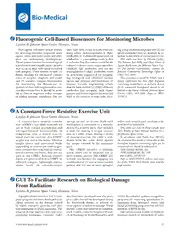
NASA Technical Reports Server (NTRS) 20100001379: A Constant-Force Resistive Exercise Unit PDF
Preview NASA Technical Reports Server (NTRS) 20100001379: A Constant-Force Resistive Exercise Unit
Bio-Medical Fluorogenic Cell-Based Biosensors for Monitoring Microbes Lyndon B. Johnson Space Center, Houston, Texas Fluorogenic cell-based sensor systems tems have been shown to work when uti- ing a degranulation response and (2) rat for detecting microbes (especially path- lizing either immunoglobulin E (IgE) IgG2a antibodies that act similarly in re- ogenic ones) and some toxins and aller- antibodies or traditionally generated rat sponse to low levels of canine parvovirus. gens are undergoing development. antibodies — a promising result in that This work was done by Theresa Curtis, These systems harness the natural signal- it indicates that the systems could be de- Noe Salazar, Joel Tabb, and Chris Chase of transduction and amplification cascades veloped to detect many target microbes. Agave BioSystems for Johnson Space Cen- that occur in mast cells upon activation Chimeric IgE antibodies and rat im- ter. For further information, contact the with antigens. These systems include (1) munoglobulin G (IgG) antibodies could Johnson Commercial Technology Office at fluidic biochips for automated contain- be genetically engineered for recogniz- (281) 483-3809. ment of samples, reagents, and wastes ing biological and chemical warfare This invention is owned by NASA, and a and (2) sensitive, compact fluorometers agents and airborne and food-borne al- patent application has been filed. Inquiries for monitoring the fluorescent re- lergens. Genetic engineering efforts concerning nonexclusive or exclusive license sponses of mast cells engineered to con- thus far have yielded (1) CD14 chimeric for its commercial development should be ad- tain fluorescent dyes. It should be possi- antibodies that recognize both Gram- dressed to the Patent Counsel, Johnson Space ble to observe responses within minutes positive and Gram-negative bacteria and Center, (281) 483-1003. Refer to MSC- of adding immune complexes. The sys- bind to the surfaces of mast cells, elicit- 23797-1. A Constant-Force Resistive Exercise Unit Lyndon B. Johnson Space Center, Houston, Texas A constant-force resistive exercise springs wound on drums. Each such within each resistive pack to obtain a de- unit (CFREU) has been invented for mechanism is contained in a module, sired level of resistance. use in both normal gravitational and denoted a resistive pack, that includes This work was done by Paul Colosky and microgravitational environments. In a shaft for making a torque connec- Tara Ruttley of Valeo Human Systems, Inc., comparison with a typical conven- tion to a cable drum. During a stroke for Johnson Space Center. tional exercise machine, this CFREU of resistive exercise, the cable is with- In accordance with Public Law 96-517, weighs less and is less bulky: Whereas drawn from the cable drum against the contractor has elected to retain title to this weight plates and associated bulky the torque exerted by the resistance invention. Inquiries concerning rights for its supporting structures are used to gen- pack. commercial use should be addressed to: erate resistive forces in typical conven- The CFREU includes a housing, Valeo Human Systems, Inc. tional exercise machines, they are not within which can be mounted one or 3350 Eastbrook Dr., Ste. 109 used in this CFREU. Instead, resistive more resistive pack(s). The CFREU also Fort Collins, CO 80525 forces are generated in this CFREU by includes mechanisms for engaging any Refer to MSC-23373-1, volume and num- relatively compact, lightweight mecha- combination of (1) one or more resistive ber of this NASA Tech Briefsissue, and the nisms based on constant-torque pack(s) and (2) one or more spring(s) page number. GUI To Facilitate Research on Biological Damage From Radiation Lyndon B. Johnson Space Center, Houston, Texas A graphical-user-interface (GUI) com- that have been developed over the years, (DNA) by radiation, pattern-recognition puter program has been developed to fa- plus codes that will be developed during programs for extracting quantitative in- cilitate research on the damage caused the foreseeable future, to address di- formation from biological assays, and by highly energetic particles and pho- verse aspects of radiation damage. These image-processing programs that aid visu- tons impinging on living organisms. The include codes that implement radiation- alization of DNA breaks. program brings together, into one com- track models, codes for biophysical mod- The radiation-track models are based on putational workspace, computer codes els of breakage of deoxyribonucleic acid transport models of interactions of radia- NASA Tech Briefs, January 2010 37
